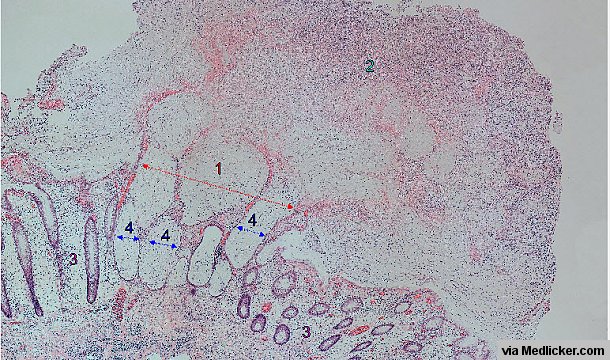Case Study 1: Can you recognize the disorder?
A 52-year old man comes to a surgery ward of a district hospital for 2 weeks of abdominal pain and bloody diarrhea. The patient underwent the following medical examinations. Your task is to check the results of the tests, diagnose the problem and answer the questions.
Tests performed and their results
Medical history (anamnesis): The patient has never suffered from similar problems before. The first time he spotted some blood in his stools was 2 days following completion of medical treatment of tonsillitis (Amoxicillin taken every 12 hours for one week). The problem keeps getting worse. Noone in the patient's family has ever suffered from blood diarrhea or chronic gastrointestinal problems.
Blood test: All results were perfectly normal, except a slight hyponatremia (129 mmol/l) and CRP (C-reactive protein), which reached 210 mg/l. Clostridium Difficile bacteria were found in the blood, but not in high concentration.
Stool test: This test confirmed large amounts of Clostridium Difficile spores in the stools.
Colonoscopy: This examination showed lots of yellowish bodies on the mucous layer of the colon. A sample was drawn from the colon for histological examination.
Histological examination of the tissue sample: This examination (see image below) showed surface erosions in the mucous layer of the colon (1) with adhesive pseudomembrane (2) consisting of fibrin, mucus and lots of neutrophiles (3). The crypts in the mucous layer were dilated (4) with exsudate forming mushroom like bodies on the mucous layer.

Quiz questions
- What is the name of this disorder?
- What is the causative agent of this condition?
- What are the treatment options for this condition?
Answers to questions from the post
<li>Pseudomembranous colitis</li>
<li>Clostridium Difficile bacteria, which overgrew in the colon due to prior antibiotic treatment (Amoxicillin).</li>
<li>The condition can be treated by antibiotics (traditionally Metronidazole or Vankomycine). New antibiotic treatment option (Fidaxomicin) is also available. In case of several relapses of the disorder, stool transplant can be performed.</li>
</ol>
| Written by: | Michal Vilímovský (EN) |
|---|---|
| Education: | Physician |
| Published: | May 24, 2014 at 10:23 PM |
| Next scheduled update: | May 24, 2016 at 10:23 PM |
Get more articles like this in your inbox
Sign up for our daily mail and get the best evidence based health, nutrition and beauty articles on the web.


Ache in left arm that you should not ignore
Alkaline water dangers: why you should not drink it
How to Avoid Sleepiness While Studying?
23 Foods That Increase Leptin Sensitivity
Low dopamine (e.g. dopamine deficiency): causes, symptoms, diagnosis and treatment options
Swollen taste buds: the ultimate guide to causes, symptoms and treatment
Thin endometrial lining: causes, symptoms, diagnosis and treatment
Pimples inside nose: the complete guide
Holes in tonsils: definition, symptoms, treatment and prevention
How to deal with an ingrown hair cyst
Allegra vs. Zyrtec vs. Claritin
Allergy to penicillin and alternative antibiotics
How to get rid of phlegm (excessive mucus) in throat? Detailed guide to medical and home remedies, symptoms and causes
What causes stomach ache after meals?
Liver blood test results explained